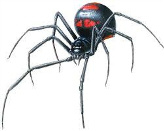Latrodectus mactans

The Black Widow spider, the species Latrodectus mactans
Female Black Widows have large, round, shiny black abdomens usually decorated with two touching red triangles on the belly. They hang upside down in the web, and the red hourglass is obvious. Sometimes dull red dots appear on the back, and occasionally the triangles dont touch, but this l/2 inch or larger, shiny black spider is unmistakably unique and eye catching. Male Black Widows are small, white and streaked with yellow and red; they are not dangerous.
Black Widow females are not aggressive but will give full attention to anything that disturbs the web.
They weave tangled webs of coarse silk in dark, quiet locations. Mature females are so large they can hardly crawl. While pest management technicians are not commonly called on for Black Widow spider control, they may well run into these spiders when inspecting crawl spaces, porches, garages, and sheds for other pests. Black Widow spiders can be found in stacked pots or baskets, firewood piles, rodent burrows, water meters, stacked boards, under bricks and stones. Usually the spiders are outside, but they may be brought inside, or the young may move inside on ground floors, Western Black Widows are likely to be found outside in bird nests, on low plants and in grape arbors. Move cautiously when treating any potential spider harborage.
Black Widow bites are immediately painful. The pain at the site of the bite increases during the first half hour following a bite. Two small red marks from the fangs will be noticeable on the skin. After the first half hour other symptoms such as headache, dizziness, shortness of breath, abdominal and back pain set in. Death seldom results from Black Widow bites to healthy adults; children and the elderly, however, are vulnerable. Victims should receive hospital treatment as soon as possible.
Habitat Alteration
Eliminate harborage sites carefully.


